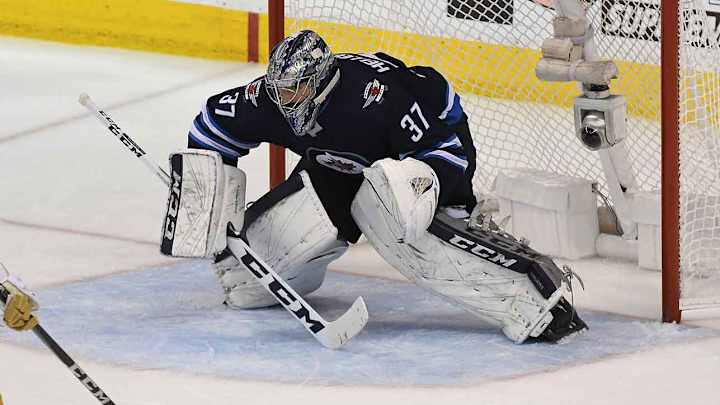NHL Goalie Equipment Continues to Shrink, Premium on Scoring

Winnipeg Jets goaltender Connor Hellebuyck recently stopped a puck near his collarbone. It was a shot that, in years past, he might not have thought about twice.
This time, it hurt.
''Didn't feel very good,'' Hellebuyck said.
He and his fellow NHL goalies will be wearing a smaller chest protector this season as the league continues to reduce the size of equipment, following recent reductions for pads and pants. The overall aim is to boost scoring while at the same time rewarding athletic ability in the crease by eliminating unnecessary padding that wasn't protecting goalies, but instead simply helping them block pucks.
A 190-pound goalie and a 240-pound goalie will no longer cut the same figure on the ice.
''Three or four years ago, talking to some of the best goalies in hockey ... they wanted us to try to find a way to make goalies look closer to the size they were,'' Kay Whitmore, NHL vice president of hockey operations, told The Canadian Press. ''The biggest complaint was, `If I weigh 50 pounds more than another guy, why do we look the same?'''
Jets Make Connor Hellebuyck the Sixth-Highest Paid Goalie With New Six-Year Contract
The league, working in conjunction with the NHL Players' Association, has focused on reducing the size of the shoulders on chest protectors by roughly an inch to make them less boxy and more form-fitting. The same goes for the padding on a goalie's arms.
Getting the new equipment has taken longer because of delays with manufacturers, but Whitmore said the league is close to what will become the ''new normal.''
''We wanted to get it right once and for all,'' he said. ''It was a more complicated piece of equipment than when we introduced the new pants or pads. We can ask companies to make changes, but things didn't move very fast until we created a standard, gave them specifics and asked them to build to it.''
Whitmore, who played the position for 155 games with four NHL teams in his 15-year pro career, said safety remains a top priority.
''There's no expectation that a goalie should have to do his job getting bruised daily,'' he said. ''I don't want to see guys go on the ice fearful of getting hit with pucks, because that's what they do for a living.''
Mathieu Schneider, special assistant to NHLPA executive director Donald Fehr, said the personal nature of chest protectors has been a challenge. Some goalies had worn their old ones for a decade or more.
''The irony is each time we've made equipment smaller, it's gotten lighter and goalies have gotten better,'' said Schneider, a former NHL defenseman. ''It's not like this snuck up on us.''
Toronto goalie Frederik Andersen said he is fine with the changes, adding that an inch of missing shoulder coverage shouldn't make a difference in terms of results if he's on his game.
''It's about being square,'' Andersen said. ''If I'm relying on that extra inch, I'm in trouble already.''
Fellow Maple Leafs goalie Garret Sparks said he thinks the change could eventually help raise the skill level at the position.
''It just pushes me to be better,'' he said. ''I'm open to the challenge as long as everybody's covered.''
NHL shooters scored more times in 2017-18 than in any season since 2005-06, averaging nearly six goals per game.
NHL's Biggest Stars Flash Fancy Footwork As an 'Added Weapon'
With that in mind, Hellebuyck said he doesn't see a need to change - for any reason.
''I'm not happy about it because it's my job,'' he said. ''And really what they want is me to be worse.''
With the process underway since 2016, Whitmore said, recent history gives him confidence the new gear will provide the game an overall benefit.
''It makes the job a little more difficult,'' he said. ''We changed other things to make goaltenders more mobile. At first they didn't agree with it, but once they started playing they felt faster, quicker and actually got better. I don't expect anything different from this once they adapt.''
